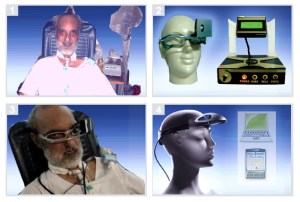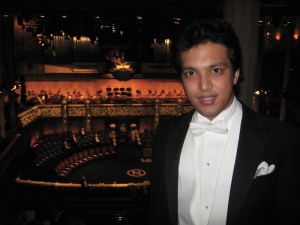Interactive Fellows Friday Feature!
Join the conversation by answering Fellows’ weekly questions via Facebook. Launching www.future.ly today, Apurv asks:
What are the most cutting-edge technologies you have seen on TED?
Click here to respond!
How has the TED Fellowship impacted you?
It’s something really significant, I’d say. Every time I speak to TED Fellows, I feel the shared passion we have to change the world, irrespective of domains and interests. The program has given a boost to my professional identity. It’s also given me confidence to challenge the status quo within a family of changemakers.
In fact, the inspiration for my current project, Future.ly, evolved out of the vivid discussions with the many Fellows at TEDIndia in 2009. What I started to realize is that innovation is not just suddenly there; it builds up, sometimes at unexpected speeds. Tomorrow’s innovation is a result of the culmination of the relentless and pioneering effort of today’s innovators. These pioneers, who foresee and work towards a vision, drive our future. They are working on cutting-edge topics, but information about them is scattered and hard to make sense of.
Together, with a bunch of TED Fellows and visionary engineers, I founded Future.ly to map the state of innovation across the world, and democratize access to cutting-edge knowledge.
Tell us more about Future.ly.
Our vision at Future.ly is to make the “cutting edge” standard, and to visualize future possibilities. We make an online platform that maps the players, influence factors, and dynamics in the innovation space around the world.
To do this, Future.ly tracks the innovators, the institution or startups they work in, the technologies they are working on, and the invisible characteristics that connect them. We aggregate relevant data sources to monitor dynamics and surface trends within different areas. And we enable the visual exploration of this data.
Our data scientist and Chief Technology Officer, Dr. Thomas Alisi, has been working in the field of data mining and semantic web over the last 10 years. As we analyze vast amounts of data, we don’t only rely on machine algorithms. We are developing an interface that augments the user’s ability to contextualize the data, and take his or her own perspective. This avoids generic projections.
The other co-founder, Mathias J. Holzmann, is strategically based in Hong Kong. Many of the exciting new innovation clusters in emerging markets are not accessible to the West. In a time of exponential progress in technology, countries like China and India could become the next hub of innovation. Future.ly wants to track that process and make it visible.
We aim to crack the innovation genome for visualizing the state of innovation across the world. This will fundamentally change the way companies, governments and institutions make their decisions. Currently, their decisions are based on a narrow set of information that does not take into consideration data that originates from non-structured sources out in the web. This is comparable to flying on autopilot, based on a map from the Middle Ages. Future.ly aims to provide the real time, updated, high-resolution map of the state of innovation.
Our first experiment with Future.ly analyzes and maps data from TED talks.
Besides the TED Conference itself, what areas of your background led to this project?
I have been working in the area of open innovation for the last 5 years. After finishing two years at the Indian Institute of Science Education & Research, I moved to Berlin to join the Palomar5 Innovation Residency (a Deutsche Telekom-funded accelerator) in October 2009. We used various corporate foresight techniques to map scenarios. In 2010 I joined Hypios, an expert search firm based on open innovation, as the VP of Strategy.
After working in these and other roles in the area of open innovation, interfaces, data mining, expert networks and corporate foresight, I am confident enough to disrupt the domain. To be very frank, the tools in this area are currently not automated. People still make scenario maps, and they do it very manually — they don’t have a very quick tool. In this era of accessible information, we can build a powerful foresight infrastructure.
You became an inventor at the ripe age of 11. Tell us about your innovations.
When I was young, I noticed that drinking water from large bottle is not easy without touching your lips to the bottle. Balancing the bottle requires secondary support from the lips, and sharing the bottle with friends then becomes unhygienic.
So, I tried my ingenuity by cutting and attaching a piece of plastic. The snake-hood shaped projection attached to the neck of the bottle, and fits comfortably on the chin, without making it necessary for a person to put their lips on the bottle itself. The invention was patented and received the Council of Scientific & Industrial Research award. That was the start for me.
Later on, my grandfather had a stroke and became mostly paralyzed. I saw him struggle, because he could not communicate, though he could see and hear. I was trying to figure out, “Why shouldn’t he be able to communicate, if his brain is functional and he can move his eyes?”
Through the previous award I got some money, which I used to create a little lab. I developed a device that detected his eyebrow movements so he could communicate. That’s how the Glabenator was born. In 2006 I patented it and licensed it to various companies.
The Glabenator was quite revolutionary because it can be manufactured in a very cost effective way. In addition, it is very accurate. One of the problems in the field of alternative and augmentative communication aid is calibration. Typically, you need to customize the device setup to fit each individual person. The Glabenator, on the other hand, uses the science of skin movements instead of the complexity of signal processing to solve this.
I have always believed that innovation is all about making tiny and naïve changes to make a giant leap.
My research shows that you have a history of going to conferences and starting up new projects. Tell us about some of the different initiatives you’ve founded.
[Laughs] Yeah, that’s true, you found a trend in the data. I never thought of that. My life has been about seeing chaos and trying to connect different opportunities. And I always feel like I need to take things to one more level. Why should I just invent technology in one area? Why not play around with many ideas? At conferences, it just seems like the time is ripe for getting people engaged in another project.
I see everything as an exciting opportunity, and it always connects back.
After working on the Glabenator, I worked on different kinds of communication and disability aids. When I went through the whole process of commercializing my innovation, what I found was that there was this gap between the industry and the innovator. The innovator has this amazing idea, but it was really complicated to transfer the innovation to the companies.
That’s why in the US, when I won the International Science and Industry Fair Award, I saw everybody at that event has amazing ideas, but they were lacking the interface to the industry. So I started IFF Global – the Innovator Factor Foundation , Open Innovation Think Tank. It was to create a forum so we can interface with the companies and create a dialogue and let the innovation transfer between them and work on how they should open up more.
I also started Technomics for open manufacturing eco-system. I couldn’t reach out to Africa or a lot of places where I wanted to bring my inventions. The communication aids can be manufactured by local entrepreneurs or technicians. So why not make the design open? It doesn’t make any sense to patent it and keep it closed. So I’ve been working on that as well: to make the blueprint of Glabenator open.
There are many aspiring social entrepreneurs out there who are trying to take their passion and ideas to the next level. What is one piece of advice you would give to them based on your own experiences and successes? Learn more about how to become a great social entrepreneur from all of the TED Fellows on the Case Foundation blog.
My advice and suggestion for a social entrepreneur is to always prototype. Don’t always focus on creating really amazing business plans. It’s really important that a social entrepreneur go back to the field and try to do a minimal viable prototype for the first project. And then try to go from there to understand if everything works. You can’t generalize a lot of this market. So it’s really important to go to the ground and do a few tests.
There was this NGO that wanted to provide toilets to improve sanitation in an African country. So they spent a lot of money and they put some toilets in a town and then they left. That’s very common with a lot of social enterprises. When they came back after one or two years, they saw that people had not changed their sanitation habits. They found out that the toilets were actually used to store rice because it was a place that stayed dry during the rain. So they converted it to a storage room.
So the problem is always out there to understand from the ground level what people want. And I think that’s very crucial to solve any problem.
What interests do you have outside of your work?
I love outdoor adventure. Growing up, I would explore the deep forest. I once took a bike ride on the world’s highest road, in the Himalayas.
And I really enjoy Victorian culture. It’s one of the reasons I moved to London. I love music and movies about this era. I think the best experience at TED was meeting Shekhar Kapur, the TED speaker, who did the Elizabeth movie. We had a long conversation, about two hours – that was so exciting.
You were invited on a Fellowship to last year’s Nobel Prize Ceremony. What was that experience like?
It was a really crazy experience. I gave a talk on the Glabenator. This particular fellowship is about bringing youth into the Nobel community, and giving the Fellows the experience of Nobel Laureates. You stay with them, you get the same experience of a Nobel Laureate. It was very exciting. And they have this whole training, where you learn to dance, because afterwards you have the whole royal ceremony, dancing with the princess and all that.
It was all so interesting, because it’s any scientist’s dream to be a Nobel laureate. Imagine having a Nobel laureate suddenly turn to you and say, “I’m feeling nervous about accepting the medal.” And then you have another Nobel laureate, saying, “I did that research 30 years back. I don’t remember that paper!”
In general, it’s a really crazy experience, but I had an especially crazy one. We all had to wear tailcoats, which are very complicated. These tuxedos incorporated screws, hooks, clips, buttons, straps and all other types of fasteners. There was somebody there to help me do all the adjustments, but he made a mistake. It was 30 minutes before the ceremony when and I sat down, and suddenly my tuxedo tore apart!
An organizer rushed me to his car, and we broke the anti-traffic in Stockholm rule. In five minutes, going the wrong way on one-way streets, we reached the place where the Nobel Laureates get their tuxedos. There were an emergency four people standing by who dressed me up and I got back to the ceremony on time. If it had been just 10 minutes later, I would have missed the ceremony!



Comments (4)
Pingback: TED Fellows 2012 申请现已开始 « 在武汉
Pingback: Fellows Friday with Apurv Mishra « TEDxMuscat